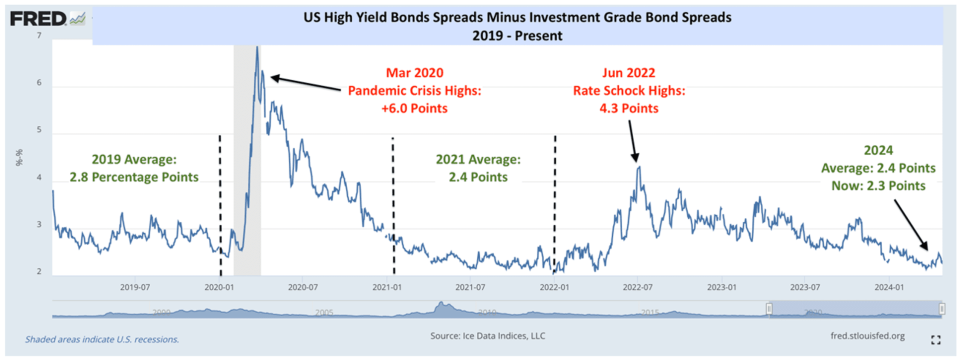Corporate bonds signal ‘clear skies’ for U.S. economy as stocks extend rally

The corporate bond market appears bullish on the U.S. economy.
Most Read from MarketWatch
“It is pricing nothing but clear skies ahead,” said Nicholas Colas, co-founder of DataTrek Research, in a note emailed Monday. “This market likely sees strong net profit margins,” he said, while reflecting “remarkably steadfast optimism regarding future economic growth.”
Investors watch corporate-bond spreads, or the compensation lenders receive over U.S. Treasurys, as they widen when worries rise that the economy is deteriorating. Corporate bondholders want to be compensated more when fearing a recession will hurt company cash flows.
But spreads have been tight lately.
And the difference between spreads on riskier U.S. high-yield and investment-grade corporate bonds is “very low versus recent history,” said Colas. “This market has a lot of confidence in sustainably high corporate profitability” and the U.S. economy continuing to grow, he said.
So far in 2024, the difference between high-yield and investment-grade corporate bonds has averaged 2.4 percentage points, and most recently tightened to 2.3 points, DataTrek found.
That’s down from an average 2.8 percentage points at the end of the last U.S. economic expansion in 2019, Colas said, and compares with a “very high” six points in March 2020 during the COVID-19 crisis.
Spreads between high-yield and investment-grade bonds came down in 2021 as fiscal and monetary policy “stabilized the economy,” but they rose again as the Federal Reserve increased interest rates in 2022 to battle the surge in inflation, a chart in the DataTrek note shows.

“Corporate bond spread differentials are signaling more confidence in the U.S. economy than at the end of the last expansion” in 2019, said Colas, “and are just as bullish as when fiscal and monetary policy were supporting American consumers and businesses” in 2021.
While high-yield corporate debt, also known as junk bonds, now appears optimistic about the U.S. economy and companies’ profit margins, Colas cautioned “history shows the corporate bond market changes course quickly and forcefully when it sees storm clouds on the horizon.”
Last week high-yield bond spreads tightened 21 basis points to 3.16 percentage points over comparable Treasurys, according to a CreditSights report Monday. U.S. investment-grade spreads last week narrowed four basis points to 0.9 percentage point.
As for U.S. government debt, the yield on the 10-year Treasury note BX:TMUBMUSD10Y was down about four basis points in midday trading Monday at around 4.63%, FactSet data show, at last check.
Meanwhile, companies in the S&P 500 index have posted net profit margins that are now “just slightly higher than in 2019,” according to DataTrek. “As U.S. economic growth slows, margin management will be a critical driver of equity valuations.”
The U.S. stock market was rising around midday Monday, with the Dow Jones Industrial Average DJIA up 0.2%, the S&P 500 SPX gaining 0.2% and the technology-heavy Nasdaq Composite COMP advancing 0.3%, according to FactSet data, at last check. Stocks climbed last week, with the S&P 500 booking its biggest weekly gain since early November as investors digested Big Tech earnings.
See: Big Tech drives S&P 500 to best week since November as investors shrug off inflation worries
With the S&P 500’s price-to-earnings ratio now higher than in 2019, U.S. companies are focusing on “cost cutting and margin management,” said Colas. “Margins have come back down to 2019 levels and companies know they need to hold or improve them to generate further earnings improvements in a slower growth environment.”
